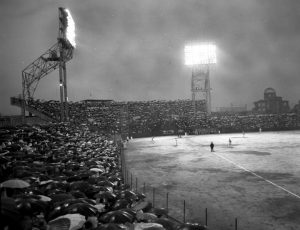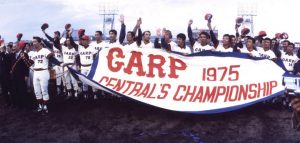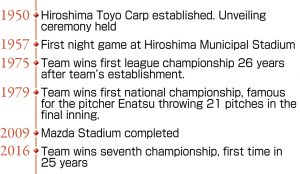Hiroshima Summit—Recovery after A-bombing, Part 1: Hiroshima Toyo Carp
Mar. 31, 2023
by Masatoshi Kimura, Senior Staff Writer
Amid Russia’s ongoing invasion of Ukraine, the summit meeting of the G7 (Group of Seven industrialized nations) is set to take place in Hiroshima in May. After Hiroshima was destroyed in the atomic bombing by the U.S. military on August 6, 1945, how was the A-bombed city able to recover? What provided emotional support for Hiroshima’s citizens at that time? The Chugoku Shimbun looks back at Hiroshima to provide a guide of recovery after wartime devastation.
In the summer 66 years ago, bright rays of light lit up the night sky in downtown Hiroshima, which had been turned into scorched ruins after the atomic bombing. The Hiroshima Municipal Stadium, home of the local Hiroshima Toyo Carp professional baseball team, was completed in July 1957, based on contributions from 10 local companies for the costs associated with stadium construction. Citizens were fascinated by the stadium’s night lights, which seemed to provide a ray of hope for the city’s recovery.
One of those citizens was Hisashi Yamamoto, 79, now a resident of Kitakyushu City in Fukuoka Prefecture. Mr. Yamamoto would often travel to the stadium from Itsukaichi-cho (now part of Hiroshima’s Saeki Ward) to watch the Carp’s games. Recalling that time, he remarked about the many shacks located around the stadium. He also said, “When coming down from Aioi Bridge, I could see the municipal stadium to my left, the A-bomb Dome on my right, and the Fukuya Department Store straight ahead in the distance. Unlike now, there were no tall buildings in the vicinity of the stadium.”
Mr. Yamamoto, his parents and older brother and sister all experienced the atomic bombing. His younger brother, three grades younger, was born in the fall of the year after the atomic bombing. Any talk about the atomic bombing was frowned upon in the family. The focus of family gatherings or other events always turned to the Hiroshima Toyo Carp, a team founded in 1950. On his own initiative, Mr. Yamamoto taught his younger brother how to play baseball, and the two would take a river ferry to visit the Hiroshima Sogo Ground Baseball Park, the Carp’s previous home stadium.
The Hiroshima Carp struggled financially during the early period of the team’s establishment but survived the crisis because of unlimited support from citizens of the city. For the team’s operations, people would donate savings withdrawn from the bank or toss their hard-earned cash into an empty sake barrel used as a donation box for the team. Mr. Yamamoto frequently watched on as his father placed money in one of the barrels. Based on such enthusiasm about the Carp from citizens, construction of the new stadium with night-game potential was successfully achieved.
The Hiroshima Municipal Stadium drew many fans. Attendance at the games increased markedly, and the team used ticket revenues to enhance team operations. At the time of the baseball draft, the Carp were able to recruit promising players. In November 1968, Mr. Yamamoto’s younger brother was the first pick in the draft for the Carp, his favorite team, and joined the Carp amid great fanfare. That was when he, Koji Yamamoto, a star player and manager nicknamed “Mr. Red Helmet” (red is the Carp’s team color), began his career as a professional baseball player.
Nevertheless, Mr. Yamamoto began to distance himself from the Carp around that time. His younger brother was being jeered by fans day after day as he struggled on the field following his joining of the team. “I am probably biased, but it was very painful to me to see my brother Koji being jeered when he couldn’t get an easy hit. My father, though, continued going to the stadium every day,” said Mr. Yamamoto. He was torn between love for his brother and the fair-weather fans whose love for him had turned to bitter hatred.
A turning point came in 1975, however. Around the end of the summer that year, the Carp were still in the running for a championship after the team had spent three consecutive years in the doldrums of last place. The fans grew expectant and the city was feverish with excitement. The players were under pressure they had never experienced before. On October 15, at Korakuen Stadium in Tokyo, the Carp won their first championship since the team was established 26 years previous.
Four days later, Mr. Yamamoto rushed to see the Carp’s final game of the season, held at the Hiroshima Municipal Stadium, and witnessed the cheers and applause for his brother, who that year won the batting championship and was voted the most valuable player, donning his uniform emblazoned with the number “8.” “I was so happy. Koji is a hard worker, the most important skill he inherited from our parents,” said Mr. Yamamoto. “As his older brother, I must confess I envied him a bit. But, he never gave up and practiced constantly.” That was a moment of an outpouring of love from Hiroshima’s citizens, who had recuperated from the devastation caused by the A-bombing and gained energy from the team based in the city they loved.
In its early period, the Hiroshima Toyo Carp hosted games at different ballparks located in Hiroshima Prefecture and the Chugoku region, besides the Hiroshima Sogo Ground Baseball Park (present-day Balcom BMW stadium, located in Hiroshima’s Nishi Ward).
The trend in those days was for stadiums to be set up to host night games. In January 1954, an initiative started for building such a stadium in Hiroshima. Although it took longer than expected, the area of Motomachi, in Hiroshima’s Naka Ward, was finally selected as the construction site in July 1956. In December that year, 10 local companies offered a total of 160 million yen to cover the construction costs for the stadium, with work on the site beginning in February 1957. The stadium was completed after a rush construction job lasting only five months. The Hiroshima Carp used it as their home field until 2008. The next year, the team moved to the new Mazda Stadium.
Over the past 73 years, total attendance for games hosted by the Hiroshima Carp has exceeded 76 million people.
(Originally published on March 31, 2023)
Amid Russia’s ongoing invasion of Ukraine, the summit meeting of the G7 (Group of Seven industrialized nations) is set to take place in Hiroshima in May. After Hiroshima was destroyed in the atomic bombing by the U.S. military on August 6, 1945, how was the A-bombed city able to recover? What provided emotional support for Hiroshima’s citizens at that time? The Chugoku Shimbun looks back at Hiroshima to provide a guide of recovery after wartime devastation.
Hiroshima Carp symbol of city’s strong resilience
In the summer 66 years ago, bright rays of light lit up the night sky in downtown Hiroshima, which had been turned into scorched ruins after the atomic bombing. The Hiroshima Municipal Stadium, home of the local Hiroshima Toyo Carp professional baseball team, was completed in July 1957, based on contributions from 10 local companies for the costs associated with stadium construction. Citizens were fascinated by the stadium’s night lights, which seemed to provide a ray of hope for the city’s recovery.
One of those citizens was Hisashi Yamamoto, 79, now a resident of Kitakyushu City in Fukuoka Prefecture. Mr. Yamamoto would often travel to the stadium from Itsukaichi-cho (now part of Hiroshima’s Saeki Ward) to watch the Carp’s games. Recalling that time, he remarked about the many shacks located around the stadium. He also said, “When coming down from Aioi Bridge, I could see the municipal stadium to my left, the A-bomb Dome on my right, and the Fukuya Department Store straight ahead in the distance. Unlike now, there were no tall buildings in the vicinity of the stadium.”
Mr. Yamamoto, his parents and older brother and sister all experienced the atomic bombing. His younger brother, three grades younger, was born in the fall of the year after the atomic bombing. Any talk about the atomic bombing was frowned upon in the family. The focus of family gatherings or other events always turned to the Hiroshima Toyo Carp, a team founded in 1950. On his own initiative, Mr. Yamamoto taught his younger brother how to play baseball, and the two would take a river ferry to visit the Hiroshima Sogo Ground Baseball Park, the Carp’s previous home stadium.
The Hiroshima Carp struggled financially during the early period of the team’s establishment but survived the crisis because of unlimited support from citizens of the city. For the team’s operations, people would donate savings withdrawn from the bank or toss their hard-earned cash into an empty sake barrel used as a donation box for the team. Mr. Yamamoto frequently watched on as his father placed money in one of the barrels. Based on such enthusiasm about the Carp from citizens, construction of the new stadium with night-game potential was successfully achieved.
The Hiroshima Municipal Stadium drew many fans. Attendance at the games increased markedly, and the team used ticket revenues to enhance team operations. At the time of the baseball draft, the Carp were able to recruit promising players. In November 1968, Mr. Yamamoto’s younger brother was the first pick in the draft for the Carp, his favorite team, and joined the Carp amid great fanfare. That was when he, Koji Yamamoto, a star player and manager nicknamed “Mr. Red Helmet” (red is the Carp’s team color), began his career as a professional baseball player.
Nevertheless, Mr. Yamamoto began to distance himself from the Carp around that time. His younger brother was being jeered by fans day after day as he struggled on the field following his joining of the team. “I am probably biased, but it was very painful to me to see my brother Koji being jeered when he couldn’t get an easy hit. My father, though, continued going to the stadium every day,” said Mr. Yamamoto. He was torn between love for his brother and the fair-weather fans whose love for him had turned to bitter hatred.
A turning point came in 1975, however. Around the end of the summer that year, the Carp were still in the running for a championship after the team had spent three consecutive years in the doldrums of last place. The fans grew expectant and the city was feverish with excitement. The players were under pressure they had never experienced before. On October 15, at Korakuen Stadium in Tokyo, the Carp won their first championship since the team was established 26 years previous.
Four days later, Mr. Yamamoto rushed to see the Carp’s final game of the season, held at the Hiroshima Municipal Stadium, and witnessed the cheers and applause for his brother, who that year won the batting championship and was voted the most valuable player, donning his uniform emblazoned with the number “8.” “I was so happy. Koji is a hard worker, the most important skill he inherited from our parents,” said Mr. Yamamoto. “As his older brother, I must confess I envied him a bit. But, he never gave up and practiced constantly.” That was a moment of an outpouring of love from Hiroshima’s citizens, who had recuperated from the devastation caused by the A-bombing and gained energy from the team based in the city they loved.
In its early period, the Hiroshima Toyo Carp hosted games at different ballparks located in Hiroshima Prefecture and the Chugoku region, besides the Hiroshima Sogo Ground Baseball Park (present-day Balcom BMW stadium, located in Hiroshima’s Nishi Ward).
The trend in those days was for stadiums to be set up to host night games. In January 1954, an initiative started for building such a stadium in Hiroshima. Although it took longer than expected, the area of Motomachi, in Hiroshima’s Naka Ward, was finally selected as the construction site in July 1956. In December that year, 10 local companies offered a total of 160 million yen to cover the construction costs for the stadium, with work on the site beginning in February 1957. The stadium was completed after a rush construction job lasting only five months. The Hiroshima Carp used it as their home field until 2008. The next year, the team moved to the new Mazda Stadium.
Over the past 73 years, total attendance for games hosted by the Hiroshima Carp has exceeded 76 million people.
(Originally published on March 31, 2023)










